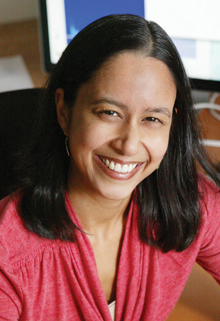Mala Murthy spends a good bit of her time studying fruit flies—specifically, the songs male fruit flies create during courtship, when they stand near a female and vibrate an extended wing.

“The fly is doing something really complicated,” explains Murthy, an assistant professor of neuroscience and molecular biology at Princeton University. “He’s measuring how fast his partner is moving, how far away she is, and constantly modulating what he sings to best match her movement.”
Murthy and her colleagues are learning to analyze the cognitive processing of both the male and female flies during this acoustic communication. “We want to understand how their brains create and recognize complex patterns,” she says.
Murthy earned a PhD at Stanford University in 2004 and then conducted postdoctoral research at the California Institute of Technology. Her work has been chosen for funding under the federal Brain Research through Advancing Innovative Neurotechnologies (BRAIN) Initiative, part of a new presidential program aimed at developing greater understanding of the human brain, and she attended a White House kickoff event. “It’s a huge boon for our field,” she says of the program. “It’s providing national attention and enabling study of the brain at a systems level—how large numbers of neurons connect, execute, and control behavior.”
The roots of Murthy’s research date to her Course 7 undergraduate work in the laboratory of biology professor Leonard Guarente, one of the first to study the effects of aging. “We worked on yeast cells and felt like pioneers, working at the bleeding edge of a new field,” recalls Murthy. “When I graduated, neuroscience programs were growing, and I thought the field would give me the same thrill—and it hasn’t disappointed.”
Another important MIT experience was participating in the Burchard Scholars program, which sponsors seminars for undergraduates with faculty from the School of Humanities, Arts, and Social Sciences. “It was an extraordinary experience,” says Murthy, who minored in history. “It made me see the thrill of doing research across disciplines. I thought the process was specific to the sciences, but I found humanities professors doing it the same way.”
Murthy and her husband, Timothy Tayler, PhD ’05, live near Princeton with their two children. “Hanging out with the kids on weekends is my hobby at the moment,” she says, and “we enjoy relaxing at our house in the woods and spending time with friends.” Murthy will give a seminar at MIT’s McGovern Institute for Brain Research on October 22.
Keep Reading
Most Popular
Large language models can do jaw-dropping things. But nobody knows exactly why.
And that's a problem. Figuring it out is one of the biggest scientific puzzles of our time and a crucial step towards controlling more powerful future models.
How scientists traced a mysterious covid case back to six toilets
When wastewater surveillance turns into a hunt for a single infected individual, the ethics get tricky.
The problem with plug-in hybrids? Their drivers.
Plug-in hybrids are often sold as a transition to EVs, but new data from Europe shows we’re still underestimating the emissions they produce.
Google DeepMind’s new generative model makes Super Mario–like games from scratch
Genie learns how to control games by watching hours and hours of video. It could help train next-gen robots too.
Stay connected
Get the latest updates from
MIT Technology Review
Discover special offers, top stories, upcoming events, and more.